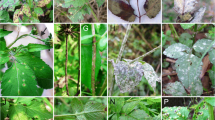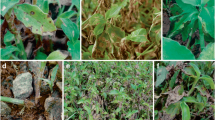Abstract
A two-year survey of the fungi associated with two important congeneric pantropical weeds, Euphorbia heterophylla and E. hirta, was conducted in part of their native range in southern Brazil. Sampling was concentrated mainly in Rio de Janeiro State and ten species were identified as pathogens of these weeds. Two taxa, Botrytis ricini and Uromyces euphorbiae, were common to both weed hosts. Alternaria euphorbiicola, Bipolaris euphorbiae, Melampsora sp., Oidium sp. and Sphaceloma poinsettiae were recorded only from E. heterophylla, whereas Colletotrichum gloeosporioides, Sphaceloma sp. and Sphaerotheca fuliginea were restricted to E. hirta. Botrytis ricini and Colletotrichum gloeosporioides are new records for E. hirta, and Alternaria euphorbiicola and Sphaerotheca fuliginea are new host records for Brazil. Bipolaris euphorbiae, previously identified as Helminthosporium sp., is considered to be the correct name for the causal agent of a major disease of E. heterophyllum in Brazil. The potential of these pathogens as biocontrol agents is discussed and the mycobiota associated with both these weeds worldwide is reviewed.
Similar content being viewed by others
References
Holm LG, Pancho J, Herberger JP, Plucknett DL. A Geographical atlas of world weeds. New York: J. Wiley & Co, 1979.
Lorenzi H. Plantas Daninhas do Brasil. Nova Odessa: published by the author, 1982.
Holm LG, Plucknett DL, Pancho JV, Herberger JP. The World's Worst Weeds: Distribution and biology. Honolulu: University Press of Hawaii, 1977.
Yorinori JT. (1985). Biological control of milk weed (Euphorbia heterophylla) with pathogenic fungi. In: Delfosse ES (ed). Proceedings of the Sixth International Symposium on Biological Control ofWeeds 1985: 667–681. Vancouver: Agriculture Canada.
Watson AK. (1991). The classical approach with plant pathogens. In: TeBeest DO (ed). Microbial control of weeds. New York: Chapman & Hall, 1991: 3–23.
Charudattan R. The mycoherbicide approach with plant pathogens. In: TeBeest D.O. (ed). Microbial control of weeds. New York: Chapman & Hall, 1991: 24–57.
Yorinori JT. Controle biológico de ervas daninhas com microorganismos. In: Anais da Segunda Reuniâo sobre Controle Biológico de Doenças de Plantas1987: 20–30. Campinas: Fundaçâo Cargill.
Yorinori JT, Gazziero DLP. Control of milk weed (Euphorbia heterophylla) with Helminthosporium sp. In: Delfosse ES (ed). Proceedings of the Seventh International Symposium on Biological Control of Weeds 1990: 571–576. Rome: 1st Sper Patol Veg (MAF).
Barreto RW, Evans HC. The mycoflora of the weed Chromolaena odorata (Asteraceae: Eupatorieae) in southern Brazil, with particular reference to fungal pathogens for biological control. Mycological Research 1994; 98: 1107–1116.
Godfrey GH. Sclerotinia ricini n. sp. parasitic on the castor bean (Ricinus communis). Phytopathology 1919; 9: 565–567.
Viégas AR. Alguns fungos do Brasil 13. Hifomicetos. BragantiaE1946; 6: 355–442.
Jong MD, Scheepens PC, Zadoks JC. Risk analysis for biological control: a Dutch case study in biocontrol of Prunus serotina by the fungus Chondrostereum purpureum.EPlant Disease 1990; 74: 189–194.
Arthur JC. Manual of the rusts in United States and Canada. Lafayette: Purdue Research Foundation,1934.
Spegazzini C. Contribucion al conocimiento de la flora micologica de las Sierras de Córdoba. Boletin de la Academia Nacional de Ciencias de la Republica Argentina 1926; 29: 114–190.
Simmons EG. Alternaria themes and variations (14–16). Mycotaxon 1986; 25, 195–202.
Reichert I. Die pilzflora Ägyptens. Botanische Jahrbücher fur Systematik, Pflanzengeschichte und Pflanzengeographie 1921; 56: 598–727.
Ziegler RS, Lozzano JC. The relationship of some Elsinoe and Sphaceloma species pathogenic on cassava and other Euphorbiaceae in Central and South America. Phytopathology 1983; 73: 293–300.
Barreto RW. Studies on the pathogenic mycoflora of selected weeds from the state of Rio de Janeiro (Brazil). [Ph.D. Thesis]. Reading, University of Reading, 1991. 588 pp.
Kern FD, Thurston HW. Additions to the Uredinales of Venezuela – IV. Mycologia 1944; 36: 503–517.
Ramachar P, Bhagyanarayana G. Nomenclatural changes in some Uredinales. Transactions of the British Mycological Society 1976; 67: 139–140.
Ramachar P, Bhagyanarayana G. A new species of Melampsora from Amduria Pradesh. Current Science 1977; 46: 315–316.
Maia HS. Fungos diversos. Publicaçôes do Instituto de Micologia da Universidade do Recife 1960; 267: 1–51.
Braun U. Amonograph of the Erysiphales (powdery mildews). Beihefte zur Nova Hedwigia 1987; 89: 1–700.
Sawada K. Descriptive catalogue of the Formosan Fungi. Agricultural Experimental Station, Formosa, Special Bulletin 1919; 1–40.
Braun U. Taxonomic notes on some powdery mildews of various genera. Mycotaxon 1986; 25: 259–269.
Hasan S. The powdery mildews as potential biological control agents of skeleton weed (Chondrilla juncea L.). In: Dunn PH (ed). Proceedings of the Second International Symposium on Biological Control of Weeds. 1971: 114–119.: Slough, Commonwealth Agricultural Bureau.
Mukerji KG, Juneja RC. Fungi of India. New Dehli: Emkay Publications,1975.
Hawksworth DL, Kirk PM, Sutton BC, Pegler DN. Ainsworth & Bisby's Dictionary of the Fungi (Eighth Edition). Wallingford, CAB International, 1995.
Kissmann KG. Plantas Infestantes e Nocivas. Vol II. BASF Brasileira, S.A.: São Paulo, 1992.
Farr DF, Bills GF, Chamuris GP, Rossman AY. Fungi of plants and plant products in the United States. St. Paul: American Phytopathology Society Press, 1989.
Sarbhoy AK, Agarwal DK, Varshney JL. Fungi of India (1977–1981). New Dehli: Associated Publishing Company, 1986.
Urtiaga R. Indice de Enfermedades en Plantas de Venezuela y Cuba. Lara: published by the author, 1986.
Tarr SAJ. A supplementary list of Sudan fungi and plant diseases. Mycological Papers 1963; 85: 1–31
Hansford CG. Contributions towards the fungus flora of Uganda V. Fungi imperfecti. Proceedings of the Linnean Society of London 1943; 155: 34–67.
Whiteside JO. A revised list of plant diseases in Rhodesia. KirkiaE1966; 5: 87–196.
Chupp C. A Monograph of the Fungus Genus Cercospora. Ithaca: published by the author, 1954.
Rios EAE. Catalogo de Enfermedades de las Plantas en la Republica de Panama. Mexico City: published by the author, 1982.
Baker RED, Dale WT. Fungi of Trinidad and Tobago. Mycological Papers 1951; 33: 1–123.
Norse D. Plant diseases in Barbados. Phytopathological Papers 1974; 18: 1–38.
Leather RI. A catalogue of some plant diseases and fungi in Jamaica. Ministry of Agriculture & Lands of Jamaica, Bulletin 1967; 61: 1–92. Rao VP, Pendse GS. The record of Curvularia lunata Boedjin causing a leaf spot of Euphorbia geniculata Orteg. in Poona. Current Science 1985; 54: 864.
Agarwal GP, Hasija J. Fungi causing plant diseases at Jabalpur (Madhya Pradesh) – VII. Journal of Indian Botanical Society 1961; 49: 542–547.
Roseñada MF. Catalogo de Enfermedades de Plantas Cubanas. La Habana: Academia de Ciencias de Cuba, 1973.
Paul YS, Kaapor JN. Taxonomy and anamorphs of Erysiphaceae-II. Indian Journal of Mycology & Plant Pathology 1987; 17: 298–304.
Rao VP, Dhande GW, Pendse GS. Leaf blight of Euphorbia geniculata Orteg caused by Helminthosporium sp. Current Science 1985; 54: 569–570.
Firman HL. A list of fungi and plant parasitic bacteria, viruses and nematodes in Fiji. Phytopathological Papers 1972; 15: 1–36
Butler EJ, Bisby GR. The fungi of India. New Delhi: The Indian Council of Agricultural Research, 1960.
Shaw DE. Plant pathogens and other microorganisms in Papua New Guinea. Department of Agriculture, Stock and Fisheries Research Bulletin, Papua New Guinea 1963; 1: 1–82.
Tarr SAJ. The fungi and plant diseases of the Sudan. Kew: CMI, 1955.
Welles CG. A provisional list of the parasitic fungi of the Philippine Islands. Philippine Agricultural Review 1922; 15: 149–202.
Brown J. Les Micro-organismes associes aux maladies des plantes dans le protectorat Britanique des Iles Salomons. Commission du Pacifique Sud. Information Document 1973; 32: 1–27.
Chandrasrikul A. A supplementary host list of plant diseases in Thailand. Bankgkok Deparment of Agriculture, Technical Bulletin (1968); 9: 1–14.
Stewart RB, Yirgou D. Index of plant diseases in Ethiopia. Haile Sellassie I University. Experimental Station Bulletin 1967; 30: 1–95.
Deighton FC. Preliminary list of fungi and diseases of plants in Sierra Leone and list of fungi collected in Sierra Leone. Bulletin of Miscellaneous Information 1936; 7: 1–37.
Ciferri R. Mycoflora Domingensis Integrata. Quaderno Instituto Botanico della Universita Pavia 1961; 19: 1–537.
Subramanian CV, Tyagi PD. List of Indian fungi (1955–1960). The Madras University Journal 1964; 34: 1–134.
Waterson JM. The fungi of Bermuda. Bulletin of the Department of Agriculture, Bermuda 1947; 23: 1–305.
Bitancourt A, Jenkins A. Estudo sobre as Miriangiales, I.EArquivos do Instituto Biológico de São Paulo 1949; 19: 93–109.
Simmonds JH. Host Index of plant diseases in Queensland. Brisbane: Queensland Department of Primary Industries, 1966.
Ondieki JJ. Host list of Kenya fungi and bacteria (a ten-year supplement, 1961-1970). East African Agricultural & Forestry Journal 1973; 37: 1–13.
Nattrass RM. Host lists of Kenya fungi and bacteria. Mycological Papers 1961; 81: 1–46.
Peregrine WTH, Siddiqui MA. A revised and annotated list of plant diseases in Malawi. Phytopathological Papers 1972; 16: 1–51.
Saccardo PA. Sylloge Fungorum 7, 1888.
Sarbhoy AK, Varshney JL, Agarwal DK. Fungi of India (1971–1976). New Dehli: Navayug Traders, 1980.
Noronha E de A. Contribuiçâo para o estudo de Melamposora ricini Passer em Portugal. Agronomia Lusitanica 1952; 14: 229–247.
Ebbels DL. A preliminary supplementary check list of Tanzanian plant diseases. Ukiriguru Research & Training Institute, Progress Report 1973; 17: 1–40.
Trotter APA. Saccardo's Sylloge FungorumE26, 1972.
Lindquist J. Royas de la Republica Argentina y Zonas Limitrofes Buenos Aires: Instituto Nacional de Tecnologia Agropecuaria, 1982.
Dale WT. A preliminary list of Jamaican Uredinales. Mycological Papers 1955; 60: 1–21.
Rada G, Stevenson JA. La Flora Fungosa Peruana. Lima: Estacion Experimental Agricola de La Molina, 1942.
Stevenson JA. Fungi of Puerto Rico and the American Virgin Islands. Contribution of Reed Herbarium 1975; 23: 1–743.
Sulocharra KK, Wilson KI, Naia MC. Some new records of Cylindrocladium quinqueseptatum from India. Agriculture Research Journal of Kerala 1982; 20: 106–108.
Piening LJ. A check list of fungi recorded from Ghana. Bulletin of the Ghana Ministry of Agriculture 1962; 2: 1–130.
Johnston A. A supplement to a host list of plant diseases in Malaya. Mycological Papers 1960; 77: 1–30.
Rao BS. Pathology. Report of the Rubber Research Institute of Malaya 1970, 1971: 68–76.
Young HE. An alternate host of Hevea mildew. Quarterly Circular of the Ceylon Rubber Research Scheme 1950; 26: 13–15.
Yen JM, Kar AK, Das BK. Studies on hyphomycetes from West Bengal, India. I. Cercospora and allied genera of West Bengal. Mycotaxon 1982; 16: 35–57.
Mathur RS. The coelomycetes of India. Debra Dun: Bishen Singh Mahendra Pel Singh, 1979.
Yen JM. Etude sur les champignons parasites du Sud-est Asiatique. V. Note sur quelques espèces d'Oidium de Malaisie. Revue de Mycologie 1966; 31: 281–310.
Tai FL. Sylloge fungorum sinicorum. Peking: Science Press, 1979.
Sawada K. Descriptive catalogue of the Formosan fungi V. Department of Agriculture, Government Research Institute of Formosa 1931; 51.
Viégas AP. Indice de Fungos da America do Sul. Campinas: Instituto Agronômico de Campinas, 1961.
Puckdeedindan P. A supplementary host list of plant diseases in Thailand. Department of Agriculture Bangkok, Technical Bulletin 1966; 7: 1–23.
Giatgong P. Host Index of plant diseases in Thailand. Bangkok: Ministry of Agriculture of Thailand, 1980.
Hennen JF, Hennen MM, Figueiredo MB. Indice das ferrugens (Uredinales) do Brasil. Arquivos do Instituto Biológico, Sâo Paulo 1982; 49 (Suplemento 1): 1–201.
Gallegos HL, Cummins GB. Uredinales (Royas) de Mexico. Culiacán, Mexico: Secretaria de Agricultura y Recursos Hidraulicos 1981.
Steiner KG. Les maladies des plantes au Togo. Bulletin du Service de la Protection des Vegetaux, Lome 1976: 1–57.
Author information
Authors and Affiliations
Rights and permissions
About this article
Cite this article
Barreto, R.W., Evans, H.C. Fungal pathogens of Euphorbia heterophylla and E. hirta in Brazil and their potential as weed biocontrol agents. Mycopathologia 141, 21–36 (1998). https://doi.org/10.1023/A:1006899831867
Issue Date:
DOI: https://doi.org/10.1023/A:1006899831867




